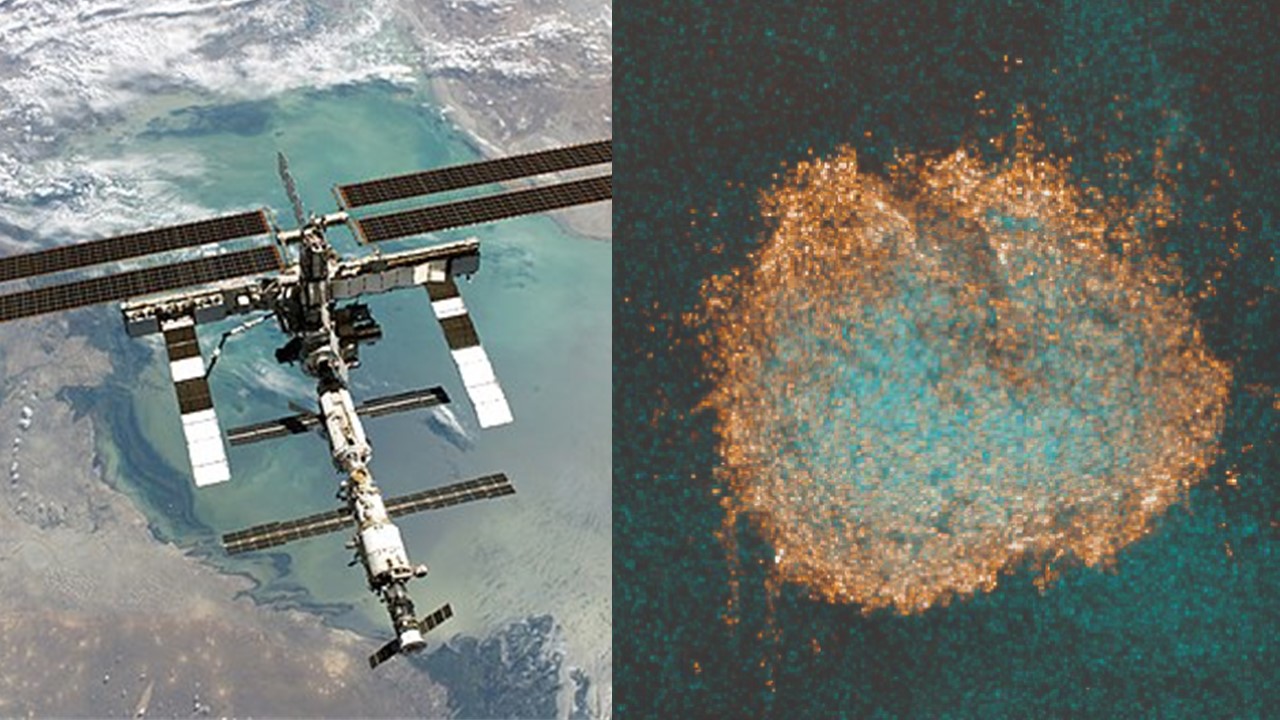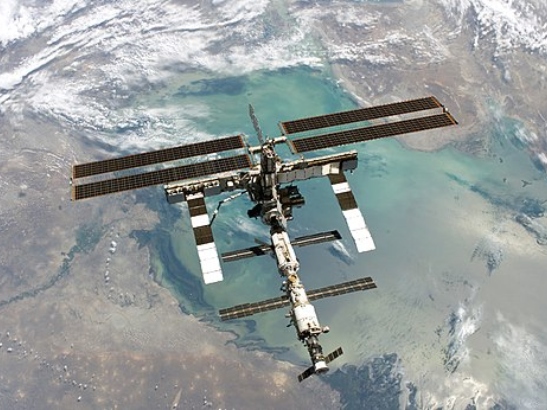
Composite image: the International Space Station and a closeup of diffuse midline glioma cells. Credit: public domain / NASA; Elisa Izquierdo / ICR
A pioneering UK research project to study the three-dimensional spread of cancer cells in microgravity is set to take place on the International Space Station.
Researchers will send samples of a childhood cancer called diffuse midline glioma to the International Space Station to gain better understanding of the development of the disease.
The researchers hope to use this new knowledge to help discover future treatments.
Poignantly, the project will study the same cancer that caused the death of Karen Armstrong, the daughter of the famous astronaut, Neil Armstrong.
Innovative collaboration
The new study, officially named the D(MG)2 study, has come about through an innovative collaboration between childhood cancer researchers at The Institute of Cancer Research, London, and partners from the UK space sector.
While scientists at The Institute of Cancer Research (ICR) will design the experiments, the UK company Kayser Space is designing and making the experimental hardware.
The UK Space Agency has provided £1.2m in funding for the project, including for a four-week phase where experiments will be hosted aboard the International Space Station.
Diffuse midline glioma – previously known as diffuse intrinsic pontine glioma (DIPG) is made up of a mix of different cell types, including cancer, immune and other cells, fitted together in a dense, complex network. It often affects very young children.
Surgery is usually not a viable option for patients, because the cancer is enmeshed in crucial areas of the brain, and chemotherapy has little effect. Radiotherapy is the only current treatment, and only as a palliative treatment.
Microgravity conditions
The D(MG)2 study will take advantage of microgravity conditions on the International Space Station to create much larger 3D structures of cancer cells than can easily be created on Earth.
Subpopulations of diffuse midline glioma cancer cells will be grown within contained Kayser Space-made bioreactor experimental units on the International Space Station, and cell cultures will be fixed at various intervals to capture different stages of growth.
The aim is to assess spatial interactions between diffuse midline glioma subclones in the unconstrained 3D microgravity environment.
Meanwhile, experimental controls will take place using the same equipment back on Earth, and in a centrifuge about the International Space Station set up to simulate conditions in 1G of gravity.
The D(MG)2 samples are set to spend four weeks on the International Space Station before being returned to Earth.
As well as providing important experimental results, the project also represents a high-profile opportunity to raise awareness of diffuse midline glioma. There is a huge unmet clinical need for the disease, and the researchers hope that raising its profile could lead to more support and funding for their efforts to find new treatments.
The UK Space Agency has also announced £1.4 million in funding for another project called MicroAge II, led by the University of Liverpool. The project is investigating how the microgravity environment makes astronauts’ muscles weaken in space in an accelerated way, compared to how muscles get weaker as we age on Earth.
Professor Chris Jones, leader of the D(MG)2 study and Professor of Childhood Cancer Biology at The Institute of Cancer Research, London, said:
“Unfortunately, survival rates for patients with diffuse midline glioma have not changed substantially since Neil Armstrong’s daughter died of the disease in the early sixties. The last 15 years, however, have revolutionised our understanding of the biological complexity of these tumours, with exciting potential new therapies entering clinical trial at last.
“Experiments such as D(MG)2 aboard the International Space Station will improve our understanding of how cancer cells interact with each other within three-dimensional structures, and hopefully lead to new ideas for disrupting tumour growth that we can take forward back in the lab.”
Professor Kristian Helin, Chief Executive at The Institute of Cancer Research, London, said:
“Taking cancer research into space might sound like science fiction, but in fact this experiment could give vital new insights into how diffuse midline glioma develops. It’s a pleasure to be working in a collaboration that spans boundaries between different areas of expertise, different scientific fields – and even the boundary that separates Earth from space.”
Minister of State at the Department for Science, Innovation and Technology, George Freeman, said:
“Space is the ultimate laboratory testbed with British scientists and astronauts harnessing the International Space Station for cutting edge research in nutrition, energy and biomedicine.
“This £2.6m project funding will help UK scientists research how to prevent brain tumours in children, and understand the biomedical processes of ageing: research with huge benefits for mankind and health systems around the world.
“Another example of the way UK strengths in different sectors from space to life science and cleantech drive technology leadership.”
Dr Paul Bate, Chief Executive of the UK Space Agency, said:
"This ground-breaking research highlights the power of space to push through barriers, revolutionise science and enhance our lives.
“Through a combination of national funding and our vital role in the European Space Agency, we’re ensuring UK scientists have access to the unique environment of the ISS for their research, which will benefit us all.”
Managing Director at Kayser Space Ltd, David Zolesi, said:
“We are thrilled to be involved in these two new UK Space Agency funded programmes and to support scientists investigating these cutting-edge research fields.
“Our role, as experts in the design and supply of instruments and systems used in outer space and especially in crewed spaceflight, is to provide public and private research groups with the tools to conduct their research and obtain great results for the benefit and well-being of all humankind.”
